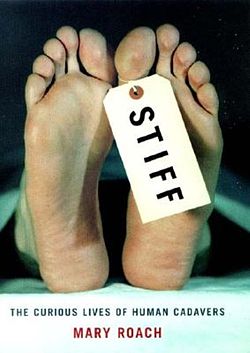 | |
| Author | Mary Roach |
|---|---|
| Language | English |
| Subject | Science, death |
| Genre | Nonfiction |
| Publisher | W. W. Norton & Company |
Publication date | 2003 |
| Publication place | United States |
| Media type | Hardback |
| Pages | 304 |
| ISBN | 0-393-32482-6 |
| OCLC | 55230887 |
Stiff: The Curious Lives of Human Cadavers is a 2003 nonfiction book by Mary Roach. Published by W. W. Norton & Company, it details the unique scientific contributions of the deceased.
Contents
In the book, Roach gives firsthand accounts of cadavers, a history of the use of cadavers, and an exploration of the surrounding ethical/moral issues. She places each chapter's content into a historical context by discussing the history of the method of using a cadaver she is about to witness.
Stiff was a New York Times Best Seller, a 2003 Barnes & Noble Discover Great New Writers pick, and one of Entertainment Weekly 's Best Books of 2003. It also won the Amazon.com Editor's Choice award in 2003, was voted as a Borders Original Voices book, and was the winner of the Elle Reader's Prize. [1] Stiff has been translated into 17 languages, including Hungarian (Hullamerev) and Lithuanian (Negyvėliai). [2] Stiff was also selected for Washington State University's Common Reading Program in 2008–09. [3]